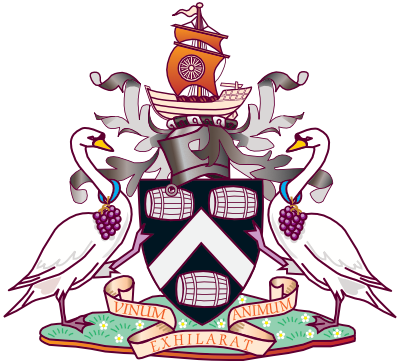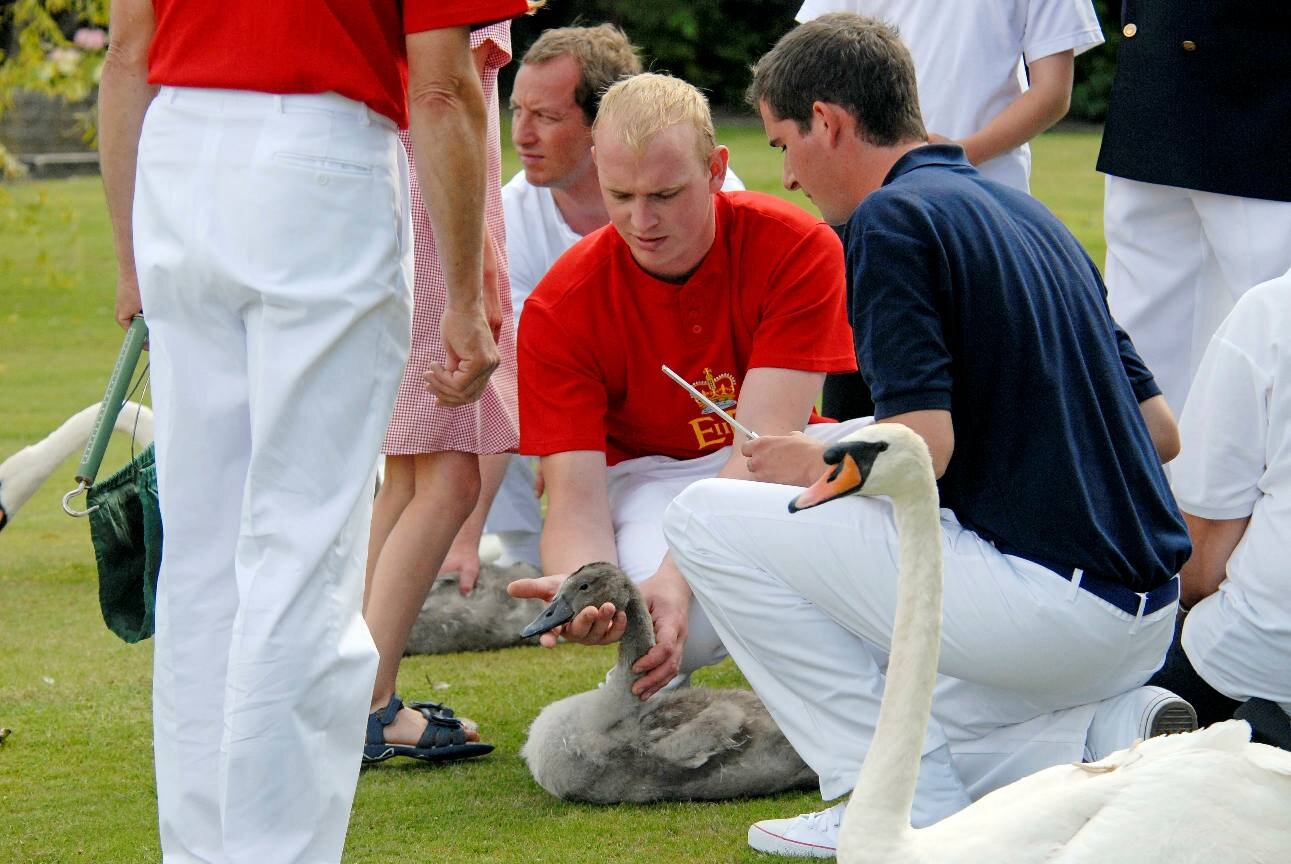Swans
Information & History

Swans & Swan Upping
The Company's right to own swans is generally said to be 'by prescription'.
This specific legal expression implies that the right has been exercised for so long that it has never been challenged. In theory it stretches as far back as 'legal memory' itself, fixed by statute as starting from the accession of Richard I in 1189.
The Vintners have therefore owned swans since 'time immemorial', in the correct legal sense of that common phrase.
This specific legal expression implies that the right has been exercised for so long that it has never been challenged. In theory it stretches as far back as 'legal memory' itself, fixed by statute as starting from the accession of Richard I in 1189.
The Vintners have therefore owned swans since 'time immemorial', in the correct legal sense of that common phrase.



Swan Upping today
The annual event of Swan Upping takes place in the third week of July.
Nowadays, Swan Upping is about checking and counting of the swans to make sure they are healthy, and educating people about the importance of Swan Upping.
This video from ‘Swan Lifeline’ provides an informative account of Swan Upping today.
Nowadays, Swan Upping is about checking and counting of the swans to make sure they are healthy, and educating people about the importance of Swan Upping.
This video from ‘Swan Lifeline’ provides an informative account of Swan Upping today.

Swan Upping Schedule
Annually during the third week of July
N.B. This schedule is subject to conditions on the river Thames and any Covid-19 restrictions which may be in place
Monday
Sunbury Lock – 09:00
Shepperton Lock – 10:45
Penton Hook Lock – 12:30
Romney Lock – 17:30
Tuesday
Eton Bridge – 09:00
Boveney Lock – 10:15
Boulters Lock – 13;00
Marlow Lock – 17:00
Wednesday
Marlow Bridge – 09:15
Hurley Lock – 10:30
Hambelden Lock – 12:00
Henley Town – 13:30
Marsh Lock – 16:00
Shiplake Lock – 17:00
Sonning Bridge – 18:00
Thursday
Sonning-0n-Thames – 09:00
Caversham Lock – 10:30
Mapledurham Lock – 12:30
Goring Lock – 17:30
Moulsford – 18:00
Friday
Moulsford – 09:00
Benson Lock – 10:15
Clifton Hampden Bridge – 13:00
Swan Upping Brochure
You may read the brochure below online (click on full screen) or use the controls to share, download a PDF version or searchA Royal Visit
In 2009 Her Majesty the Queen visited the royal custom of Swan Upping. Although she may own all unmarked mute swans in open water in Britain, she had never before made a personal visit to watch this ancient ritual.
The usual starting point in Sunbury in Surrey was changed to accommodate Her Majesty as she travelled by boat from Boveny Lock at Eton Wick to Oakley Court. Here she met with Swan Uppers and watched cygnets being weighed, marked and measured.
Her Majesty is known as the Seigneur Of The Swans during the historic ceremony.
The usual starting point in Sunbury in Surrey was changed to accommodate Her Majesty as she travelled by boat from Boveny Lock at Eton Wick to Oakley Court. Here she met with Swan Uppers and watched cygnets being weighed, marked and measured.
Her Majesty is known as the Seigneur Of The Swans during the historic ceremony.
Swan Upping over the years!
Additional history
The first documentary reference to the Vintners owning swans comes from 1509, when the Company’s “Under-Swanherd”, named James, was paid 4 shillings at the time of the ‘great frost’ for ‘upping the Master’s swans’, plus a further 4 pence for boat hire at the same time. These early Company accounts are at the British Library (‘Egerton manuscripts’), but we have a copy on microfilm at Vintners’ Hall. No Company accounts survive earlier than 1507.
The Company’s right to own swans is generally said to be ‘by prescription’. This specific legal expression implies that the right has been exercised for so long that it has never been challenged. In theory it stretches as far back as ‘legal memory’ itself, fixed by statute as starting from the accession of Richard I in 1189. The Vintners have therefore owned swans since ‘time immemorial’, in the correct legal sense of that common phrase.
A statute of Edward IV of 1483 is frequently referred to in various printed sources on the ‘swan royalty’. This states that only someone possessing freehold land worth at least 5 marks p.a. (between £3 and £4) had the right to own swans. In a 16th-century lawsuit between the Crown and Lady Joan Young it was clarified that this applied only on a person’s private waters; on the common and open river, swans could only be marked, and therefore owned, by the monarch (and their agents), or ‘by prescription’. The fact that the 1483 statute does not appear to have been followed by any later grant to the Vintners has led to the (not unreasonable) assumption that the Vintners were already swan owners by that date.
A useful book on the subject is Norman Ticehurst’s ‘The Mute Swan in England’, published in 1957. This refers to a grant of swan-rights to the Dyers’ Company in 1473 and also remarks that the Vintners “received their swan-rights from the Crown between 1472 and 1483”, although no specific evidence for this is supplied. Ticehurst also points out that the swan mark used by the Vintners for centuries, until it was altered in 1863, was the same as that used by David Selby, a prominent Vintner in the mid 15th century, implying that the Company’s swan ownership may derive from around that time or a little later.
Thus although the first documentary reference to the Vintners’ Company as swan owners is from 1509, it is likely that the Company’s ownership goes well back into the 15th century and possibly even earlier.
Swans were a prized source of meat in the Middle Ages and after, and their quills were also used for writing. Quills from geese were much more commonly used, cheaper, and preferred by many people who found a swan’s quill too stiff to write with easily. However, a swan’s quill was said to last as long as 50 goose quills, and Queen Elizabeth I preferred to write with a swan’s quill. Quills were invariably trimmed of all or most of their feathers to make writing easier – it is a common mistake in historical dramas to see someone pretending to write with a quill which still has all its feathers intact! Swans’ feathers may also have been used decoratively in hats, and the down used for stuffing quilts and pillows. At Vintners’ Hall we have a beautiful cape made from swans’ down, though this dates from the 1920s – relatively modern by Vintners’ standards!
The Company’s right to own swans is generally said to be ‘by prescription’. This specific legal expression implies that the right has been exercised for so long that it has never been challenged. In theory it stretches as far back as ‘legal memory’ itself, fixed by statute as starting from the accession of Richard I in 1189. The Vintners have therefore owned swans since ‘time immemorial’, in the correct legal sense of that common phrase.
A statute of Edward IV of 1483 is frequently referred to in various printed sources on the ‘swan royalty’. This states that only someone possessing freehold land worth at least 5 marks p.a. (between £3 and £4) had the right to own swans. In a 16th-century lawsuit between the Crown and Lady Joan Young it was clarified that this applied only on a person’s private waters; on the common and open river, swans could only be marked, and therefore owned, by the monarch (and their agents), or ‘by prescription’. The fact that the 1483 statute does not appear to have been followed by any later grant to the Vintners has led to the (not unreasonable) assumption that the Vintners were already swan owners by that date.
A useful book on the subject is Norman Ticehurst’s ‘The Mute Swan in England’, published in 1957. This refers to a grant of swan-rights to the Dyers’ Company in 1473 and also remarks that the Vintners “received their swan-rights from the Crown between 1472 and 1483”, although no specific evidence for this is supplied. Ticehurst also points out that the swan mark used by the Vintners for centuries, until it was altered in 1863, was the same as that used by David Selby, a prominent Vintner in the mid 15th century, implying that the Company’s swan ownership may derive from around that time or a little later.
Thus although the first documentary reference to the Vintners’ Company as swan owners is from 1509, it is likely that the Company’s ownership goes well back into the 15th century and possibly even earlier.
Swans were a prized source of meat in the Middle Ages and after, and their quills were also used for writing. Quills from geese were much more commonly used, cheaper, and preferred by many people who found a swan’s quill too stiff to write with easily. However, a swan’s quill was said to last as long as 50 goose quills, and Queen Elizabeth I preferred to write with a swan’s quill. Quills were invariably trimmed of all or most of their feathers to make writing easier – it is a common mistake in historical dramas to see someone pretending to write with a quill which still has all its feathers intact! Swans’ feathers may also have been used decoratively in hats, and the down used for stuffing quilts and pillows. At Vintners’ Hall we have a beautiful cape made from swans’ down, though this dates from the 1920s – relatively modern by Vintners’ standards!


























